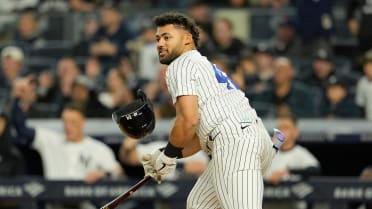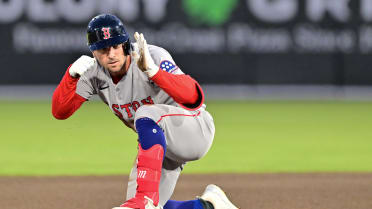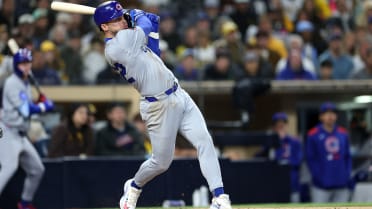Everyone knows how Francisco Lindor powered the Mets into the National League Championship Series with two of the biggest swings in franchise history -- the home run against the Braves that sent the Mets to the playoffs, and the grand slam against the Phillies that sent them into their showdown with the Dodgers for the pennant.
It's a well-told story by now, too, how Lindor's surge began in May, when the Mets moved him into the leadoff spot and he, almost overnight, transformed into an MVP contender for the rest of the season.
But here's what actually changed for Lindor at the plate. There's been a big, measurable difference in how Lindor has been squaring up the baseball over the last five months.
Maybe the switch to leadoff was the trigger for Lindor that helped him find his stroke. But what stands out is this: Lindor's quality of contact -- and his quality of swings -- has dramatically shifted from the first arc of his season, his April slump, to the second arc of his season, which began in May and has continued through the end of the regular season, through two postseason series, and is still happening right now.
Essentially, Lindor is swinging with much more authority. In particular, now, when Lindor puts his bat on the baseball, he is connecting with the barrel of the bat far more consistently.
That might sound obvious. How else would Lindor have 34 home runs and counting between the regular season and playoffs? But this is actually something that we can measure for the first time in 2024, thanks to Statcast's new bat tracking metrics that were introduced this year.
One of those is squared-up contact -- which essentially shows you how often a hitter hits the ball on the sweet spot of the bat. "Squared-up" means the batter reached at least 80% of the maximum possible exit velocity that a particular swing could produce, based on the bat speed of that swing. A hitter can only achieve that level of exit velocity when he hits the ball on the sweet spot of the bat.
And that is what stands out for Lindor.
- Lindor in April: 56.6% of total batted balls squared up
- Lindor since May: 71.4% of total batted balls squared up
That is a major boost. And Lindor's upward trend of squared-up contact shows you that by the time he started batting leadoff on May 18, the process was already in place for him to turn his -- and the Mets' -- season around.
By now, Lindor has been squaring up baseballs at one of the highest rates in the Major Leagues for the vast majority of 2024.
Highest % of total batted balls squared up, since May
Of hitters with 350+ batted balls
- Luis Arraez: 74.2%
- Francisco Lindor: 71.4%
- Shohei Ohtani: 71.1%
- Freddie Freeman: 70.5%
- Bryan Reynolds: 69.9%
It's important to watch what's been happening on Lindor's contact, because his turnaround this season actually isn't because he's swinging and missing less, or striking out less. That's not what's happening. Lindor was making contact all along, it was just poor, inefficient contact. And that's what's changed. It's not about more balls in play, it's about better balls in play.
The more squared-up swings Lindor puts on the baseball, the more potential damage he can do with those swings. And he's connected for more squared-up batted balls than nearly any other hitter.
Most squared-up batted balls in 2024
Including postseason
- Luis Arraez: 458
- Marcus Semien: 355
- Francisco Lindor: 349
- José Ramírez: 340
- Bobby Witt Jr.: 331
There's one more piece for Lindor. He coupled his improved ability to hit the ball on the sweet spot of the bat with a little extra bat speed.
- Lindor in April: 71.7 mph bat speed
- Lindor since May: 72.5 mph bat speed
At the end of April, Lindor's bat speed was sitting at 71.7 mph, right around league average. But in May, when the switch flipped, his bat speed jumped almost a full mph, to 72.6 mph.
And that's basically where it's stayed for the rest of the season. From May onward, Lindor's average bat speed is 72.5 mph (although it did dip a little late in the year as Lindor started dealing with his back injury) -- not quite Aaron Judge or Shohei Ohtani-level bat speed, but firmly above average. And adding bat speed matters.
More contact on the sweet spot of the bat, at higher swing speeds, means Lindor has simply been able to hit the ball a lot harder. His average exit velocity has jumped over 4 mph since April, and his hard-hit rate (how often he hits the ball at least 95 mph) has jumped by almost 10 percentage points. And he's gone even higher in the playoffs.
- Lindor in April: 87.6 mph exit velo, 40.6% hard-hit rate
- Lindor since May: 91.8 mph exit velo, 49.4% hard-hit rate
- Lindor in the playoffs: 93.2 mph exit velo, 57.1% hard-hit rate
Here, for example, is what Lindor's home run swing looked like on his grand slam off Phillies closer Carlos Estévez in the Mets' NLDS clincher. Lindor reached a bat speed of 77.1 mph, one of his faster home run swings of the year (and easily above the "fast swing" threshold of 75-plus mph) -- which is what let him turn around a 99.4 mph fastball from Estévez and drive it at a season-best 109.5 mph over the fence.
That Lindor home run reflects the highest level of swing quality: when a hitter has both a fast swing speed and squares up the baseball. Statcast categorizes those swings -- high bat speed plus squared-up contact -- as blasts.
Lindor's "blast" swings have rocketed up since May just like his squared-up swings have. That matters a lot for his power hitting, because the higher your bat speed when you square the ball up, the more likely you are to end up with an extra-base hit, or a home run.
- Lindor in April: 22.9% of batted balls qualified as blasts
- Lindor since May: 34.8% of batted balls qualified as blasts
Lindor is now one of the 2024 season leaders in blasts, with 165 entering the NLCS. That ranks 11th in the Majors, and fourth among NL hitters. (Lindor's fellow MVP candidate and NLCS opponent Shohei Ohtani is the Major League leader.)
Most blasts, NL hitters, 2024
Including postseason
- Shohei Ohtani: 209
- Manny Machado: 178
- William Contreras: 175
- Francisco Lindor: 165
- Kyle Schwarber: 163
Lindor's home run off the Braves' Pierce Johnson that clinched the Mets' playoff spot on the final day of the regular season, for example, was one of his blast swings. Here's what that swing looked like, including a top-tier bat speed of 80.2 mph.
The improvement in Lindor's swing quality has translated to the same improvement in his contact quality. That's a natural connection, but it's still striking to see how Lindor's expected batting average, expected slugging percentage and overall expected wOBA -- which are based on the exit velocity and launch angle of all of his batted balls -- have changed.
Lindor's quality of contact stats for 2024
- Through April: .255 xBA / .423 xSLG / .330 xwOBA
- Since May: .293 xBA / .562 xSLG / .393 xwOBA
- Season overall: .286 xBA / .537 xSLG / .382 xwOBA
Lindor's xBA jumped by almost 40 points starting in May. His xSLG jumped by almost 150 points. His xwOBA jumped by over 60 points.
By the end of the regular season, Lindor ranked in the 93rd percentile of MLB in expected batting average, in the 95th percentile of MLB in expected slugging and in the 96th percentile of MLB in expected wOBA -- the measure of a hitter's all-around value.
Of course, to the Mets, in the playoffs, Lindor's value has been beyond measure. But to get here, he had to fix his swings five months ago.
David Adler is a reporter for MLB.com based in New York.




